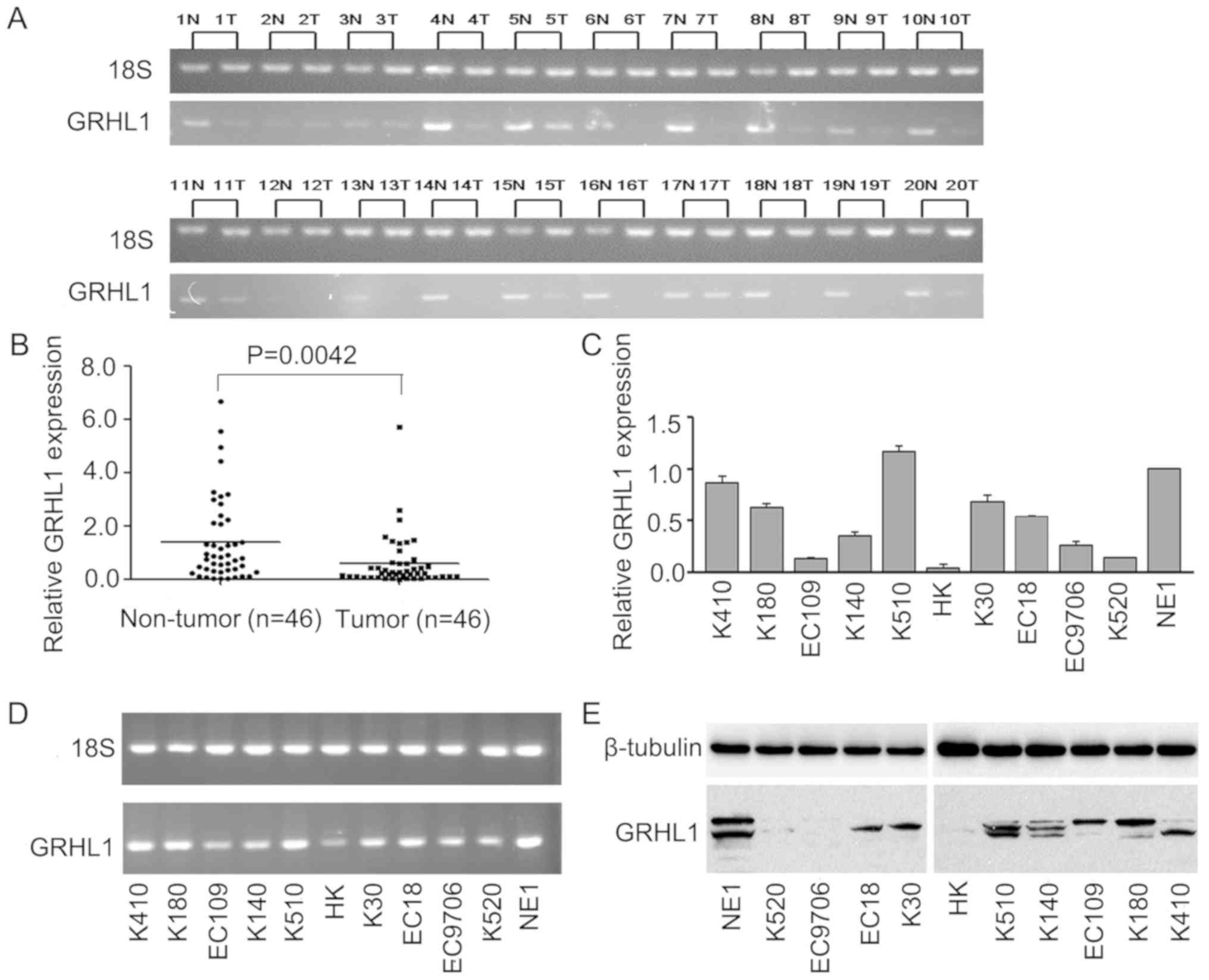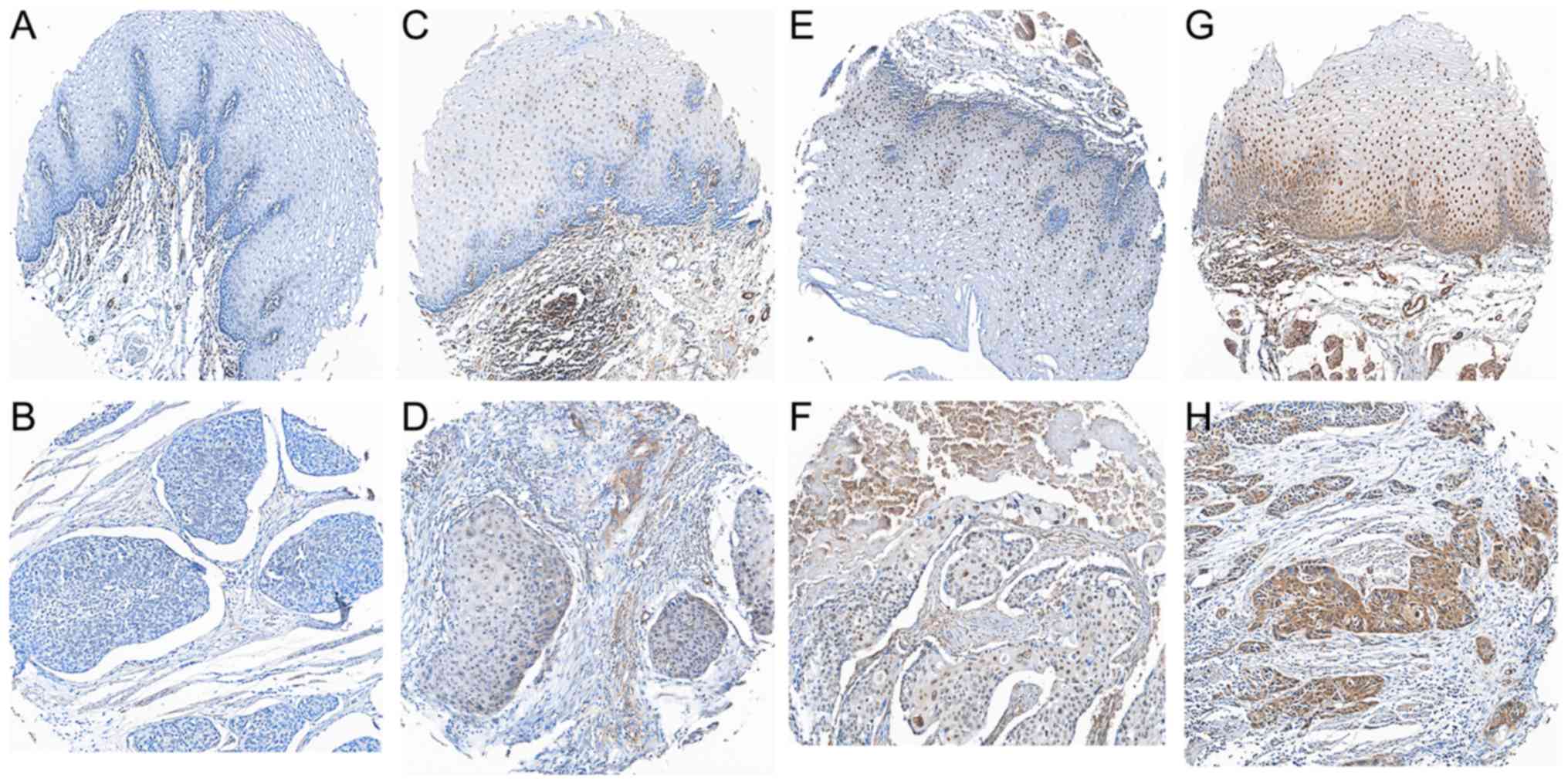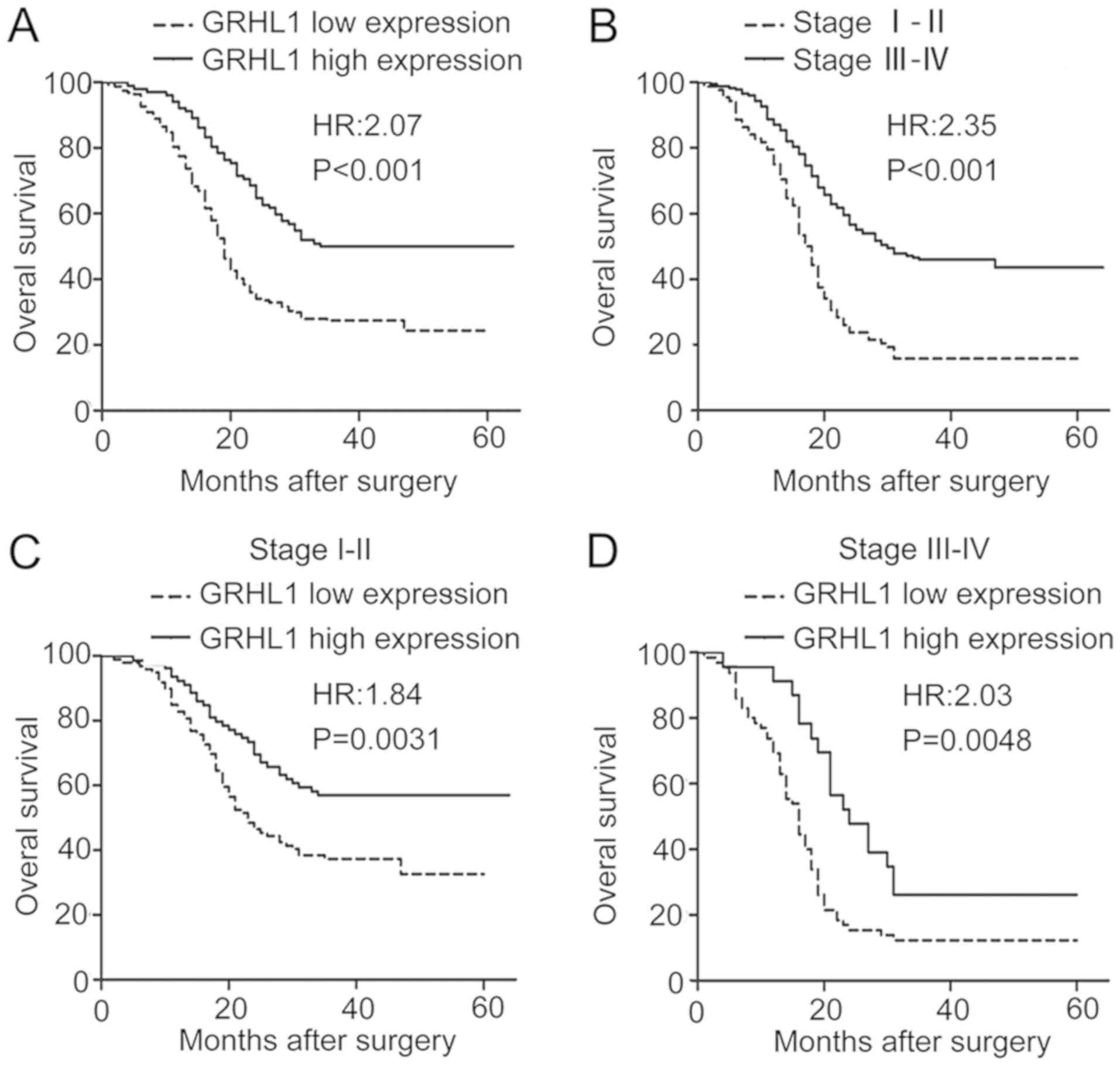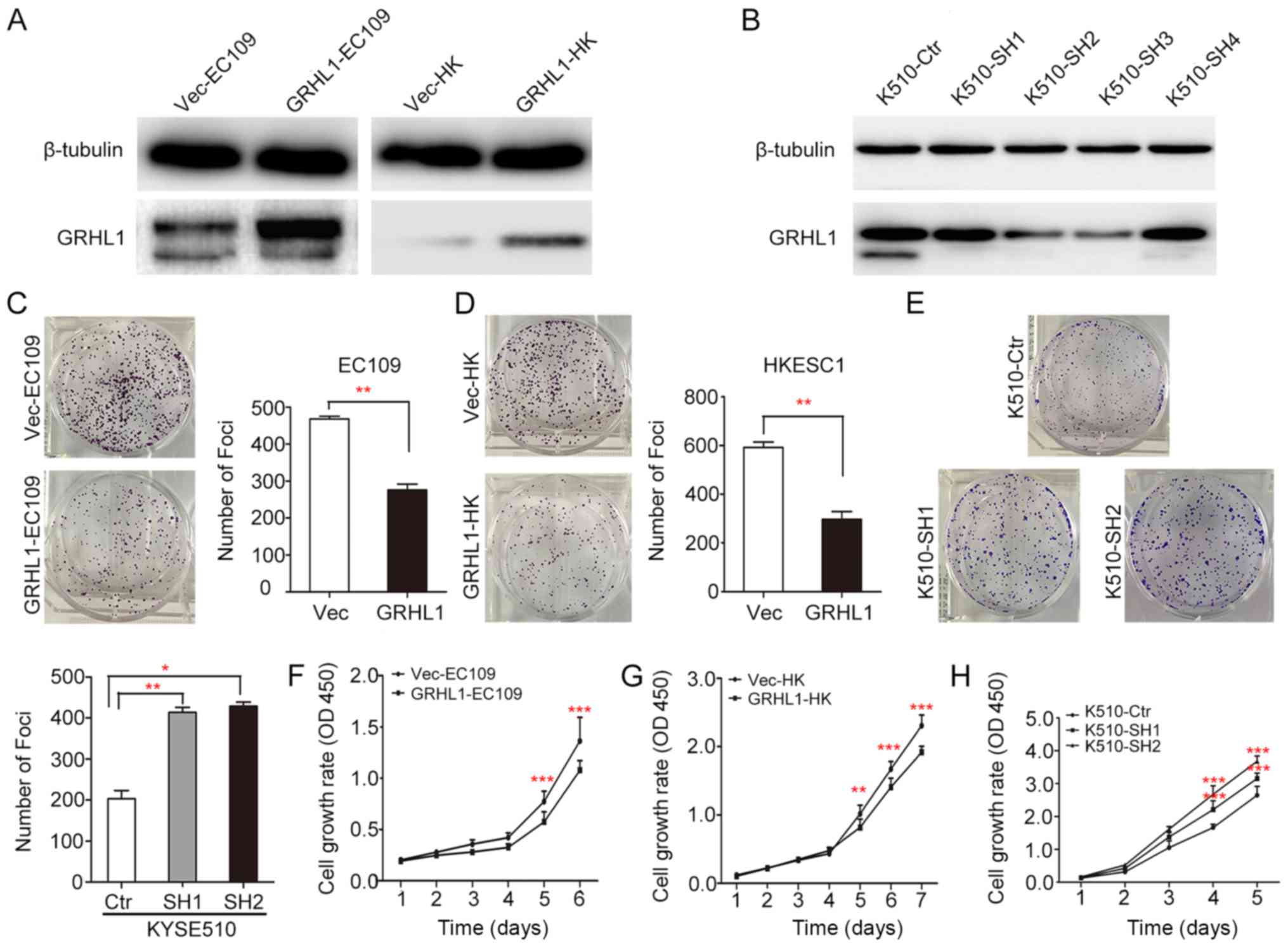Suppressor gene GRHL1 is associated with prognosis in patients with oesophageal squamous cell carcinoma
- Authors:
- Published online on: February 25, 2019 https://doi.org/10.3892/ol.2019.10072
- Pages: 4313-4320
-
Copyright: © Li et al. This is an open access article distributed under the terms of Creative Commons Attribution License.
Abstract
Introduction
Oesophageal cancer is considered to be among the most harmful known tumor types. Previous studies reported that ~480,000 cases of oesophageal cancer are diagnosed worldwide each year, making it the 8th most commonly occurring cancer. It has also been reported that >400,000 mortalities occur due to oesophageal cancer each year wordwide, rendering Oesophageal cancer was the 6th most deadly tumor worldwide as of 2017 (Cancer Statistics, 2017) (1). China is a nation with an exceptionally high prevalence of oesophageal cancer, and oesophageal cancer is the 4th most common cause of mortality in China. Contrary to the western nations, the majority of patients with oesophageal cancer in China have oesophageal squamous cell carcinoma (ESCC), which represents >90% of cases (2). Tumor invasion and metastasis is one of the primary explanations for the failure of the oesophageal cancer treatment and patient mortality (2). The identification of oesophageal growth associated factors, together with elucidating the underlying molecular mechanisms, has been hypothesized to aid in developing more efficient therapeutics for oesophageal cancer. The aim of the present study was to identify oesophageal cancer biomarkers and investigate focused treatment.
Grainyhead like transcription factor 1 (GRHL1) is a 70 kDa protein and belongs in the homologous group of GRH families, which function as transcription factors in warm-blooded animals (3). The GRH family was initially identified in Drosophila, and Drosophila GRH are located on the surface of the ectoderm, therefore contributing to epidermal structure, and serve a crucial role in embryonic advancement, neurodevelopment, epidermal formation and wound-healing (4). The mammalian GRHL family comprises of three individuals, including GRHL1, GRHL2 and GRHL3 (5). A previous study demonstrated that the GRHL family serves a role in skin squamous cell carcinoma, oral squamous cell carcinoma, breast cancer, stomach cancer, liver cancer, colorectal cancer, renal clear cell carcinoma, neuroblastoma tumor and cervical cancer (3).
There is a limited amount of research investigating the role of GRHL1 in tumors. In a neuroblastoma investigation, Fabian et al (6) demonstrated that patients with a high expression of GRHL1 had an improved clinical prognosis and longer disease-free survival. GRHL1, as a tumor silencer, serves an important role in the repression of tumor cell clone development, proliferation and tumorigenic capacity in mice. Mlacki et al (7) examined the role of GRHL1 knockout in mice with cutaneous squamous cell carcinoma and identified that the GRHL1 deletion promoted the advancement of benign papilloma to malignant squamous cell carcinoma. The aim of the present study was to investigate whether the low expression of GRHL1 is associated with a poor prognosis in patients with ESCC.
Materials and methods
Cell lines and cell culture
Immortalized normal esophageal epithelial cell line NE1 was obtained from Professor George Tsao's laboratory (Department of Anatomy, The University of Hong Kong) in 2006. Chinese ESCC cell lines [HKESC1(HK), EC109 and EC9706] and six Japanese ESCC cell lines [KYSE30(K30), KYSE140(K140), KYSE180(K180), KYSE410(K410), KYSE510(K510), and KYSE520(K520)] were kindly provided by Professor Srivastava (Department of Pathology, The University of Hong Kong). The human ESCC cell lines HK, EC18, EC109, EC9706, K30, K140, K180, K410, K510 and K520 were cultured in DMEM (Invitrogen; Thermo Fisher Scientific, Inc., Waltham, MA, USA) supplemented with 10% fetal bovine serum (Invitrogen; Thermo Fisher Scientific, Inc.). The oesophageal epithelial cell line (NE1) was cultured in Keratinocyte-SFM & EpiLife (1:1; Invitrogen; Thermo Fisher Scientific, Inc.), supplemented with bovine pituitary extract (BPE) (35 ug/ml; Invitrogen; Thermo Fisher Scientific, Inc.). All cell lines were cultured at 37°C in a 5% CO2 incubator.
Patients and tissue specimens
A total of 60 matched fresh ESCC samples and normal oesophageal epithelium specimens were obtained via surgical resection at Linzhou People's Hospital (Henan, China) between January 2015 and June 2015 for RNA extraction. Additionally, an aggregate of 266 formalin-fixed paraffin-embedded (fixed in 4% paraformaldehyde at room temperature for 10 h, in 4-mm thick sections) ESCC tissues and the comparing normal oesophageal epithelia were obtained from Linzhou Cancer Hospital (Henan, China) between January 2002 and February 2005 for the tumor tissue microarray (TMA). All patients enrolled in this investigation did not receive preoperative treatment. The clinical attributes of all patients are presented in Table I. The accompanying end focuses (time to the date of death were assessed). The present study was approved by the Institutional Ethics Review Board of the First Associated Hospital (Zhengzhou University), and written informed consent form was obtained from each patient.
Immunohistochemical staining
Briefly, a TMA segment was de-paraffinized (dimethylbenzene I, II, IIII, each for 5 min) and rehydrated (alcohol gradient: 100, 95, 75 and 50%, each for 5 min), and the endogenous peroxidase activity was blocked using 3% hydrogen peroxide for a period of 15 min. For antigen retrieval, the TMA slide was microwave-treated (100°C) in 10 mM citrate buffer (pH 6.0, Na3C6H5O7·2H2O: 1.2054 g, C6H8O7·H2O: 0.189 g, dissolving in 1 liter of ddH2O) for 10 min. Then Bovine serum albumin (5%, Invitrogen; Thermo Fisher Scientific, Inc.) was applied to block non-specific binding at temperature for 1 h. The primary antibody used was rabbit anti-GRHL1 (cat. no. NBP1-81321, Novus Biologicals, LLC, Littleton, CO, USA), which was diluted to a ratio of 2 ug/ml and incubated with the slides for overnight at 4°C. The nucleus was counterstained with the use of Meyer's haematoxylin (at room temperature for 20 sec). Representative photomicrographs were captured with a Vectra (PerkinElmer, Shanghai, China). Slides were observed under light microscopy at ×40 magnification. GRHL1 immunoreactivity was calculated via the scores for the level of GRHL1-positive cells 1: ≥5%, <25%; 2: ≥25, <50; 3: ≥50, <75%; and 4: ≥75% and the force of GRHL1-positive staining (negative, 0; weak, 1; moderate, 2; or strong, 3). Enlightening outcomes were observed in 266 sets of ESCC cases. However, invalid cases included lost cases as well as Non-specific staining.
RNA extraction, reverse transcription-quantitative polymerase chain reaction (RT-qPCR) and agarose gel electrophoresis
Total RNA was separated from the cell lines with the use of TRIzol® reagent (Invitrogen; Thermo Fisher Scientific, Inc.). The extricated RNA (2 µg) was reverse transcribed with the use of the Takara PrimeScript™RT reagent kit with gDNA Eraser FastQuant RT kit (Takara Bio, Inc., Otsu, Japan), and the cDNA productions were stored at −20°C until subsequent use. RT-qPCR was conducted on the Roche LightCycler 480 sequence detection system (Roche Diagnostics, Basel, Switzerland) in 10 µl responses containing 0.5 µl reverse transcription product, 5 µl SYBR® Green SuperMix (Roche Diagnostics), 0.25 µl of each PCR forward primer and reverse primer, and 4 µl ddH2O. The reactions were pre-incubated at 95°C for 10 min, followed by 45 cycles of denaturation at 95°C for 15 sec and expansion at 60°C for 1 min, at that point the temperature was inclined from 60°C to 95°C (via automatic program processing) for the purpose of obtaining a melting curve. The accompanying PCR primers were: GRHL1, forward, 5′-CAAACGGCCAGTGTTGGTTC-3′, and reverse, 5′-TGCTCATCATCGCTTTGGTCG-3′; 18s, forward, 5′-GTAACCCGTTGAACCCCATT-3′, and reverse, 5′-CCATCCAATCGGTAGTAGCG-3′. The gene expression level was expressed as 2-∆∆Cq, where ∆Cq=Cq (gene)-Cq (18s) (8). The expression level in control cells was considered as 1. The experiments were conducted in triplicate. 18s was used as the standardization control. Agarose gel electrophoresis was conducted for the analysis of the mRNA expression level of GRHL1. The accompanying PCR primers were the same as RT-qPCR. PCR amplifications were conducted with the use of the GoTaq Green Master mix kit (Promega Corporation, Madison, WI, USA) and PCR cycling conditions adhered to the following: 95°C for 5 min, followed by 35 cycles of 95°C for 30 sec, 60°C for 30 sec and 72°C for 30 sec, with extension at 72°C for 7 min (S1000 Thermal Cycler; Bio-Rad Laboratories, Inc., Hercules, CA, USA; http://www.bio-rad.com). The PCR items were examined by 1.5% agarose gel electrophoresis.
Establishment of GRHL1 expression and deletion clone in ESCC cell lines
A lentiviral construct containing GRHL1 (GeneCopoeia, Inc., Rockville, MD, USA) was packaged with the use of a Lenti-Pac™ HIV Expression Packaging kit (GeneCopoeia, Inc.) in 293 cells. GRHL1-treatment lentivirus was employed to steadily transfect ESCC cells (EC109 and HKESC1), in order to construct the GRHL1-overexpressing cells. Empty vector-transfected cells were established as the controls. Short hairpin (sh)RNA against GRHL1 (GeneCopoeia, Inc.) was transfected into KYSE510 cells with the use of a Lenti-Pac HIV Expression Packaging kit in 293 cells, according to the manufacturer's protocol. The cells transfected with the mixed inhibitor (NC; Shanghai GenePharma Co., Ltd., Shanghai, China) were employed as the negative controls.
Antibodies and western blotting
Protein was extracted from ESCC cells by ice-cold lysis buffer supplemented with protease inhibitor cocktail (Pierce; Thermo Fisher Scientific, Inc.) and quantified using the BCA Protein Assay kit (Beyotime Institute of Biotechnology, Haimen, China). Protein samples (30 µg) were separated on a 15% SDS-PAGE gel and then transferred onto PVDF membrane (Millipore, Billerica, MA, USA). Following blocking with 5% skimmed milk in Tris-buffered saline with 0.1% Tween-20 (TBST) at room temperature for 2 h, the membranes were incubated overnight at 4°C with rabbit anti-human GRHL1 monoclonal primary antibody (1:250, cat. no. NBP1-81321, Novus Biologicals, LLC, Littleton, CO, USA). Subsequently, The membrane was rinsed with TBST and incubated with anti-rabbit IgG (1:2,000; cat. no. CST-14708, Cell Signaling Technology, Inc., Danvers, MA, USA) antibody conjugated to horseradish peroxidase at room temperature for 2 h. Blots were visualized with enhanced chemiluminescence (GE Healthcare, Chicago, IL, USA). β-tubulin primary antibody (1:1,000; cat. no. CST-2146, Cell Signaling Technology, Inc.) was used as a loading control.
Cell growth assay and foci formation assay
In order to investigate cell growth, 1×103 cells (GRHL1, Vec-EC109; GRHL1, Vec-HK; shGRHL1, shCtr-K510) were plated in 96-well plates and the cell development rate was examined using a Cell Counting Kit-8 kit (Dojindo Molecular Technologies, Inc., Kumamoto, Japan), according to the manufacturer's protocol. For the foci formation assay, 1×103 cells were plated in 6-well plates, and following two weeks of culture (37°C, 5% CO2), colonies comprised of >50 cells stained with 1% crystal violet were counted.
Statistical analysis
Data are presented as the mean ± standard error of the mean and SPSS standard V.22.0 (IBM Corp., Armonk, NY, USA) was employed for statistical analysis. The unpaired student's t test or two-way ANOVA (post-hoc test, mean ± SEM) were used to investigate differences among two groups or a multi-group comparison. Survival analysis was carried out with the use of the Kaplan-Meier and log-rank tests and the associations between GRHL1 expression and clinicopathological factors were calculated by Pearson's χ2 test or Fisher's exact test. Univariate and multivariate Cox proportional hazard regression model were used to calculate the survival hazard risk. P<0.05 was considered to indicate a statistically significant difference.
Results
GRHL1 is downregulated in ESCC cells and tissues. The mRNA levels of GRHL1 in 20 pairs of fresh ESCC tissues and ordinary oesophageal epithelial tissues, and in 46 combinations of fresh ESCC tissues and normal oesophageal epithelial tissues revealed that GRHL1 mRNA was expressed at extensively low levels in the ESCC tissues (Fig. 1A and B). The mRNA and protein expression levels of GRHL1 in the normal oesophageal epithelial cell line NE1 and ESCC cell lines were evaluated by RT-qPCR, agarose gel electrophoresis and western blot analysis. In contrast to the NE1 cells, GRHL1 was downregulated in the majority of the examined ESCC cell lines at the mRNA and protein levels; however, this downregulation was not exhibited in KYSE510 cells (Fig. 1C-E).
Associations between GRHL1 expression and the clinicopathological features of ESCC
In an attempt to identify the associations between the GRHL1 protein expression and the clinical factors of patients with ESCC, the present study analysed the protein expression of GRHL1 in an arrangement of 266 paraffin-embedded ESCC TMA using immunohistochemistry. Delegate images of GRHL1 immunohistochemical staining in clinical ordinary oesophageal epithelial tissues and ESCC tissues are presented in Fig. 2A-H. Positive staining for GRHL1 was primarily observed in the nucleus of typical oesophageal epithelial cells and ESCC cells. Using a staining index of 5 as the cut-off point in the 266 patients with ESCC inspection, 164 (61.7%) patients were categorised as exhibiting low GRHL1 expression, and 102 (38.3%) patients exhibited a high expression of GRHL1. As presented in Table I, low GRHL1 expression was significantly associated with the tumor invasion (P=0.008), clinical stage (P=0.004) and patient mortality (P<0.001). No significant associations were observed between GRHL1 expression and other clinical factors, including age, sex, differentiation or lymph node (LN) metastasis (P>0.05).
Downregulation of GRHL1 is associated with a poor prognosis and is an independent prognostic factor in ESCC
The association between GRHL1 expression and OS in ESCC was examined using Kaplan-Meier analysis as well as the log-rank test. As evident from Fig. 3, a low GRHL1 expression was associated with a significantly reduced OS [hazard ratio (HR), 2.07 95% confidence interval (CI), 1.491–2.881; P<0.001; Fig. 3A]. Additionally, stage III–IV was associated with a reduced OS (HR, 2.345; 95% CI, 1.727–3.186; P <0.001; Fig. 3B). In addition, the early stage (stage I–II, n=178) and the advanced stage subgroup (stage III–IV, n=88) of patients with a low GRHL1 expression had a significantly reduced OS (stage I–II: HR, 1.840; 95% CI, 1.229–2.756; P=0.0031; and stage III–IV: HR, 2.032; 95% CI, 1.241–3.325; P=0.0048) in comparison with those who had a high GRHL1 expression (Fig. 3C and D). These outcomes indicated that the low expression of GRHL1 is associated with a reduced prognosis in ESCC. Univariate and multivariate Cox regression analyses were performed in order to investigate the impact of various clinical factors, including GRHL1 expression, sex, age, differentiation, tumor invasion, LN metastasis and clinical stage. As evident from Table II, the univariate analyses demonstrated that low GRHL1 expression was associated with notably reduced OS (P<0.001), compared with high GRHL1 expression. Furthermore, in multivariate analysis, poor differentiation was also associated with a significantly reduced OS (P=0.049), compared with patients with moderate and well differentiation. In univariate analysis, T3 (Fibre layer invasion) was associated with reduced OS (P<0.001), compared with T1 (mucosae invasion). LN metastasis was associated with significantly reduced OS (P<0.001), compared with patients without LN metastasis. The advanced stage of disease was also associated with significantly reduced OS (P<0.001), compared with early stage. The results also revealed that sex and age had no significant effect on OS (P>0.05), with multivariate analysis confirming that the low expression levels of GRHL1 and differentiation degrees were independent prognostic factors associated with the OS in ESCC (P<0.05).
GRHL1 exerts tumor-suppressive ability
In order to investigate the tumor-suppressive ability of GRHL1, GRHL1 was transfected into the EC109 and HKESC1 ESCC cell lines (termed GRHL1-EC109 and GRHL1-HK cells, respectively). EC109 and HKESC1 cells transfected with an empty vector (Vec-EC109 and Vec-HK, respectively) were used as controls. Expression of the GRHL1 gene and protein in these transfectants were confirmed using western blotting (Fig. 4A). KYSE510 cells were transfected using shGRHL1 (K510-SH2 and K510-SH3) or shCtr (K510-ctr). Expression of the depleted GRHL1 gene and protein in these transfectants were analysed by western blotting (Fig. 4B). In comparison with the control cells, the in vitro experiments revealed that the high expression of GRHL1 could successfully suppress tumorigenic capacity in its transfected cells, which was evidenced by a significant decrease in foci formation frequency (P<0.01, ANOVA; Fig. 4C-E), together with the inhibition of cell development rate (P<0.001, ANOVA; Fig. 4F-H).
Discussion
With the advancement of diagnostic techniques and therapeutic interventions in recent years, the clinical prognosis of patients with ESCC has improved significantly. However, patients in the same clinical phase of ESCC exhibit differing clinical results when receiving identical treatments (9). Therefore, it is imperative to distinguish novel biomarkers, which may accurately predict patient prognosis and aid in developing individualized treatments for patients with ESCC. As demonstrated by the present study, GRHL1 is down-regulated in ESCC at the mRNA and protein levels, and a low expression of GRHL1 is associated with a reduced prognosis in patients with ESCC. Additionally, GRHL1 was recognized as an independent prognostic factor in the multivariate investigation, which demonstrated that GRHL1 has the potential to serve as a novel prognostic biomarker for the control of the clinical practice and research on ESCC.
In the present study, depleted GRHL1 was observed in 164/266 (61.7%) ESCC tissues. Additionally, the downregulation of GRHL1 was revealed to be associated with a reduced patient prognosis, and may serve as an independent prognostic factor in ESCC. The study by Fabian et al reanalyzed the microarray expression data from a cohort of 476 neuroblastoma cases (6,10). Kaplan-Meier analysis demonstrated that the high level of GRHL1 expression in tumors is closely associated with improve the patient's overall survival rate (6). Mlacki et al investigated the role of GRHL1 in knockout mice with cutaneous squamous cell carcinoma, and observed that the tumors in knockout mice were also bigger in size and had earlier onset (7). In the light of these results we can state that loss of GRHL1 supports the progression of papillomas to carcinomas in a mouse model. However, the loss of GRHL1 does not effect the initiation of cancerous transformation in keratinocytes. Considering Mlacki's observations, the present study concluded that the loss of GRHL1 promotes the progression of papillomas to carcinomas in the knockout mice model (7). It was consequently hypothesized that GRHL1 exhibits tumor heterogeneity; however, further investigations are required in order to investigate the function of GRHL1 in various malignancies. Collectively, the results of the present study indicated that low GRHL1 expression is associated with tumor progression and patient clinical outcomes in ESCC.
GRHL1 has tumor-suppressive capacity, Fabian et al demonstrated that GRHL1 is epigenetically and transcriptionally subdued by the chromatin-altering chemical histone deacetylase 3 (HDAC3) in association with MYCN (6). It has also been reported that the re-expression of GRHL1 in MYCN-enhanced neuroblastoma cells inhibits cell proliferation, in addition to impeding the development in xenografts associated with the tumor at a molecular level (6). The molecular mechanism of GRHL1, in Lodrini's exploration, demonstrated that MYCN and HDAC2 work together in order to inhibit microRNA-183, and has tumor-suppressive attributes in neuroblastoma cells, via co-localization to the miR-183 promoter (11). The particular molecular mechanism through which GRHL1 assumes a tumor silencer role in ESCC has not yet been completely elucidated, and therefore requires further investigation.
The present study demonstrated that GRHL1 serves a crucial role in the progression of ESCC. However, due to certain limitations in the present study, the results obtained require further investigation and verification. For example, due to objective factors, the cell function experiments following the inhibition of GRHL1 in cell lines were not performed completely. In addition, the present study lacks sufficient immunohistochemistry results for Clinical Stage IV ESCC tissues. Furthermore, the specific molecular mechanism of the GRHL1 gene in tumor suppression has not been completely elucidated, further research is still required, and future studies should investigate whether the promoter region of GRHL1 is methylated, resulting in downregulation of its expression in ESCC. At the same time, it was detected whether the downregulation of GRHL1 expression caused abnormal apoptosis in ESCC, and the antitumor protection mechanism of the organism was destroyed, resulting in uncontrolled tumor growth and advanced cancer. We hypothesized that further research into the function and mechanism of activity of GRHL1 will identify novel therapeutic targets for ESCC, and future research will investigate the exact mechanisms by which GRHL1 inhibits the progression of ESCC.
In conclusion, the present study demonstrated that GRHL1 is downregulated at the mRNA and protein levels in ESCC and the low expression of GRHL1 is associated with a reduced OS in ESCC. GRHL1 has tumor-suppressive capacity in ESCC, and has the potential to serve as a novel prognostic biomarker and potential therapeutic target in ESCC.
Acknowledgements
Not applicable.
Funding
The present study received support from the National Natural Science Foundation of China (grant no. H1602).
Availability of data and materials
The datasets used and/or analyzed during the current study are available from the corresponding author on reasonable request.
Authors' contributions
ML, ZL, YQ and XG were responsible for study conception and design. ML and ZL developed the methodology. ML, ZL and YQ undertook the acquisition and analysis and interpretation of data. ML, ZL and YQ undertook the writing, review, and/or revision of the manuscript. Administrative, technical, or material support was provided by ML, ZL and YQ, and YQ and XG supervised the study. All authors read and approved the final manuscript.
Ethics approval and consent to participate
The present study was approved by the Institutional Ethics Review Board of the First Associated Hospital (Zhengzhou University). All patients gave written informed consent to participate in the study and the data were anonymized.
Patient consent for publications
Not applicable.
Competing interests
The authors declare that they have no competing interests.
References
|
Siegel RL, Miller KD and Jemal A: Cancer statistics, 2017. CA Cancer J Clin. 67:7–30. 2017. View Article : Google Scholar : PubMed/NCBI | |
|
Torre LA, Bray F, Siegel RL, Ferlay J, Lortet-Tieulent J and Jemal A: Global cancer statistics, 2012. CA Cancer J Clin. 65:87–108. 2015. View Article : Google Scholar : PubMed/NCBI | |
|
Mlacki M, Kikulska A, Krzywinska E, Pawlak M and Wilanowski T: Recent discoveries concerning the involvement of transcription factors from the Grainyhead-like family in cancer. Exp Biol Med (Maywood). 240:1396–1401. 2015. View Article : Google Scholar : PubMed/NCBI | |
|
Bray SJ, Burke B, Brown NH and Hirsh J: Embryonic expression pattern of a family of Drosophila proteins that interact with a central nervous system regulatory element. Genes Dev. 3:1130–1145. 1989. View Article : Google Scholar : PubMed/NCBI | |
|
Wilanowski T, Tuckfield A, Cerruti L, O'Connell S, Saint R, Parekh V, Tao J, Cunningham JM and Jane SM: A highly conserved novel family of mammalian developmental transcription factors related to Drosophila grainyhead. Mech Dev. 114:37–50. 2002. View Article : Google Scholar : PubMed/NCBI | |
|
Fabian J, Lodrini M, Oehme I, Schier MC, Thole TM, Hielscher T, Kopp-Schneider A, Opitz L, Capper D, von Deimling A, et al: GRHL1 acts as tumor suppressor in neuroblastoma and is negatively regulated by MYCN and HDAC3. Cancer Res. 74:2604–2616. 2014. View Article : Google Scholar : PubMed/NCBI | |
|
Mlacki M, Darido C, Jane SM and Wilanowski T: Loss of Grainy head-like 1 is associated with disruption of the epidermal barrier and squamous cell carcinoma of the skin. PLoS One. 9:e892472014. View Article : Google Scholar : PubMed/NCBI | |
|
Livak KJ and Schmittgen TD: Analysis of relative gene expression data using real-time quantitative PCR and the 2(-Delta Delta C(T)) method. Methods. 25:402–408. 2001. View Article : Google Scholar : PubMed/NCBI | |
|
Dorth JA, Pura JA, Palta M, Willett CG, Uronis HE, D'Amico TA and Czito BG: Patterns of recurrence after trimodality therapy for esophageal cancer. Cancer. 120:2099–2105. 2014. View Article : Google Scholar : PubMed/NCBI | |
|
Oberthuer A, Juraeva D, Li L, Kahlert Y, Westermann F, Eils R, Berthold F, Shi L, Wolfinger RD, Fischer M and Brors B: Comparison of performance of one-color and two-color gene-expression analyses in predicting clinical endpoints of neuroblastoma patients. Pharmacogenomics J. 10:258–266. 2010. View Article : Google Scholar : PubMed/NCBI | |
|
Lodrini M, Oehme I, Schroeder C, Milde T, Schier MC, Kopp-Schneider A, Schulte JH, Fischer M, De Preter K, Pattyn F, et al: MYCN and HDAC2 cooperate to repress miR-183 signaling in neuroblastoma. Nucleic Acids Res. 41:6018–6133. 2013. View Article : Google Scholar : PubMed/NCBI | |
|
Rice TW, Ishwaran H, Blackstone EH, Hofstetter WL, Kelsen DP and Apperson-Hansen C; Worldwide Esophageal Cancer Collaboration Investigators, : Recommendations for clinical staging (cTNM) of cancer of the esophagus and esophagogastric junction for the 8th edition AJCC/UICC staging manuals. Dis Esophagus. 29:913–919. 2016. View Article : Google Scholar : PubMed/NCBI |













